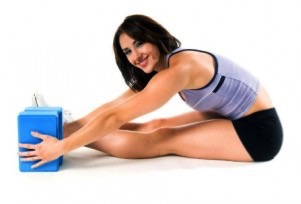No longer merely the chill out method of Indian gurus or a fashion token for the hipster elite, yoga has seen a huge rise in popularity in recent years. Athletes spanning various sporting disciplines from football to MMA all sing the praises of the ancient techniques but what are the benefits of yoga and how can it improve your training? Our resident yogi bear Toby Cryne goes on the quest for enlightenment.
What are the benefits of yoga?
Though they may sound like something straight out of Angelina Jolie’s book of children’s names, Ashtanga, Hatha, Bikram,Vinyasa are in fact, the four most common yoga routines practised in the UK today.
As one of the oldest and most widely circulated exercise regimes known to man, yoga is often seen as merely a symbolic expression of religious practice and ancient eastern medicine. And though, in terms of its beginnings, this may in fact be somewhat true, the modern world has hijacked the ancient practice, doffed it in a lick of face paint and a sari and re-branded it as functional exercise routine.
The benefits of yoga are now touted across sporting disciplines as varied as MMA, triathlon and even power-lifting (click the sports for specific yoga advice). As the importance of a strong core for the prevention of injury is becoming ever more apparent, yoga has become the standard by which all other practices are judged and has been since the dawn of physical culture in the late 1800′s.
Many early accounts of bodybuilding and physical culture can be dated back to India in the middle ages where the early practices of physical development coincide closely with the ancient practices of yoga.
Where can I do it?
Thankfully, now the stigma of hippy culture has finally worn off and the benefits of yoga are lauded in the mainstream, yoga classes exist in even the most hard line warehouse gyms and MMA centres. Generally speaking, most gyms and fitness centres will charge extra for yoga as the instructors don’t work in the gym itself. Yoga schools can be expensive, especially branded ones such as Bikram. Look for private instructors who teach small classes which are usually cheaper. For those who are really keen, yoga retreats exist all over the globe in exotic locations as far reaching as Scunthorpe.
https://www.youtube.com/watch?time_continue=1&v=0o0kNeOyH98
Which practice is best for me?
All forms of yoga stem from the same, or at least a similar root. That said, the different schools of thought are still responsible for different ideals and practices. Put simply, each practice is taught based on the individual interpretations of the school and the instructor. Each style varies in intensity and difficulty though most positions can be either made either simpler or more challenging depending on the skill level of the participant.
Hatha: The most widely circulated and gentle form of practice, Hatha combines a few different styles in a simple and easy to manage format. Ideal for beginners, the various moves can be developed and manipulated to more challenging ones when the skill level is improved.
Difficulty Level: Beginner
For: Those with little flexibility; bodybuilders, power lifters, strength athletes.
Ashtanga: A continuous set of poses, or asanas, that utilise a specific breathing technique exclusive to Ashtanga. Though growing in popularity, Ashtanga is generally thought to be a more challenging form of yoga.
Difficulty Level: Intermediate
For: Those with good flexibility; martial artists, gymnasts.
Bikram: The ever growing practice of Bikram has made a name for itself over recent years as a form of hot yoga. The discipline is practiced in a 40˚C room with intensive levels of humidity and is certainly not for the faint of heart. Developed by the now infamous Bikram Choudhury in the 1970’s, the popular form features 26 poses performed in a systematic routine to develop the entire body. Typically marketed as more of a workout than a spiritual journey, Bikram has continued its meteoric rise despite controversies and lawsuits.
Difficulty Level: Sweaty
For: High intensity athletes; circuit trainers, CrossFit,
Vinyasa: A faster paced version of Hatha, Vinyasa is a challenging format that places a great deal of focus on the breath during each asana. Continuous sequences and specified breathing allow for a more cardiovascular focused series of movements that can be used to improve breathing technique in athletes.
Difficulty Level: Beginner
For: Endurance sports; runners, triathletes, cyclists.

The basics
Ready to take the plunge? Try these simple poses out for size before you hit a class.
Downward Facing Dog: A bit like the common plank, the DFD is a fundamental part of any yoga routine and acts as a bridging pose between more difficult movements.
https://www.youtube.com/watch?v=8faMqI8hp2w
Warrior Pose: Ideal for gaining hamstring flexibility and developing the lower body, the WP teaches the coordination needed for later poses.
https://www.youtube.com/watch?v=yfcBgXfKZuU
Child’s Pose: The resting pose for between poses, the CP is probably one of the most heavily used of all the poses. Used at any point when a break is needed, the CP will help ease the transition between difficult poses.
https://www.youtube.com/watch?v=l-mtV34Afok
Equipment
Though classes can be quite expensive (especially Bikram and other branded classes), yoga is actually surprisingly uncostly if practiced in the home.
Yoga mat: Though many schools and gyms often supply yoga mats, it is thought of as more hygienic to bring your own. Generally thought of as the only real must-have item, a non-slip yoga mat provides comfort and grip throughout the asanas.
Yoga block: Most of mankind was not created for performing the splits or placing the feet behind the head and for those with less flexibility, a yoga block is a must have item. Designed support the lumbar when performing seated postures, for extended stretching poses and for balance during standing routines.
Yoga straps: Designed to assist in the performance of a new stretch, yoga straps can be used when two connecting points such as the feet and hands are unable to touch each other, making otherwise unachievable stretches possible.

